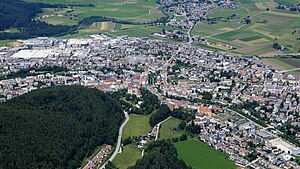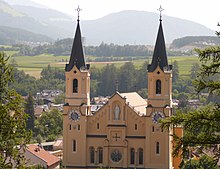Bruneck
Bruneck | |
|---|---|
| Stadtgemeinde Bruneck Città di Brunico | |
 June 2018 view over Bruneck | |
| Coordinates:46°48′N11°56′E/ 46.800°N 11.933°E | |
| Country | Italy |
| Region | Trentino-Alto Adige/Südtirol |
| Province | South Tyrol(BZ) |
| Frazioni | Aufhofen (Villa Santa Caterina), Dietenheim (Teodone), Luns (Lunes), Reischach (Riscone), Stegen (Stegona), St. Georgen (San Giorgio) |
| Government | |
| • Mayor | Roland Griessmair (SVP) |
| Area | |
| • Total | 45 km2(17 sq mi) |
| Elevation | 838 m (2,749 ft) |
| Population (Dec 2018)[2] | |
| • Total | 16,716 |
| • Density | 370/km2(960/sq mi) |
| Demonym(s) | German: Brunecker Italian: Brunicensi |
| Time zone | UTC+1(CET) |
| • Summer (DST) | UTC+2(CEST) |
| Postal code | 39031 |
| Dialing code | 0474 |
| Website | Official website |
Bruneck(German pronunciation:[ˈbrunɛk];[3]Italian:Brunico[bruˈniːko]or[ˈbruːniko]Ladin:BornechorBurnech;Latin:BruneciumorBrunopolis) is the largest town in thePuster Valleyin theItalianprovince ofSouth Tyrol.
Geography[edit]

Bruneck rises up in the middle of a wide valley (perhaps an ancient lake basin) and lies at the confluence of theAhrwith theRienz,which itself flows into theEisackriver. Here the northernTauferer Ahrntalside valley and the southernVal Badiaof theGran Egacreek join the broad Pustertal. Bruneck wide valley, located between the two straits ofKiensdownstream andPerchaupstream, delimited to the South by the circular elevation ofKronplatzand opened to the North in the Tauferer Tal (Val di Tures), owes its conformation and extent to the action of glaciers and, subsequently, to the erosive action of the waters.[4]The municipal area stretches from the slopes of theZillertal Alpsin the west to theRieserferner Groupof theHigh Tauernrange in the east. In the south rises theKronplatzmassif, part of theDolomites,the BruneckHausbergwith theMessner Mountain MuseumCoronesbuilding designed byZaha Hadidon top at an elevation of 2,275 metres (7,464 ft) and a popularskiarea.
The Bruneck town centre is located about 35 kilometres (22 mi) east ofBrixenand 70 kilometres (43 mi) of the regional capitalBolzano.To the east, the town is 40 kilometres (25 mi) from Winnebach (part ofInnichen) on the border withEast TyrolinAustria.
Linguistic distribution[edit]
According to the 2011 census, 82.47% of the population speak German, 15.24% Italian and 2.29% Ladin as first language.[5]
History[edit]
The wide valley where today the city of Bruneck rises up was initially uninhabited until it was occupied by theRomans;the local populations, because of the danger of flooding of the river Rienz, used to live on the sides of the valley or in the neighbouring hills. The valley floor was soon to be populated since the Puster Valley was the main arterial road used to connect Northern Italy to the Danube area of Europe. In 1901, following the passage of the PustrissacountshipfromHenry IVto theBishopof Brixen Altvino, the episcopal administration was established in the village of St. Caterina. Nearby the small village of Ragen rose up as well as somefarmsteads,which, after a donation from the noblewoman Svainilde, around 1000, became part of the possessions of the Brixen bishops.[4]

The town was probably named after its founder, theBrixenprince-bishop Bruno von Kirchberg, and first appeared asBrunekein a deed issued on 23 February 1256. At that time, the town consisted of two rows of houses forming a narrow lane. During the turbulent times of theinterregnumupon the death of theHohenstaufenemperorFrederick IIin 1250, the prince-bishop had a fortress erected above the town, which was first mentioned in 1276. The castle was significantly enlarged under Prince-Bishop Albert von Enn, who also had the town walls and moat completed until 1336.

Soon thereafter, further rows of houses were built outside the eastern gate. These led to the small Church of Our Lady (today's Church of the Assumption of Mary). The first church inside the town walls (at first only a small chapel) was built beneath the castle by the BruneckerburgherNiklas von Stuck. This church is today theRainkirche.In 1358,Heinrich von Stuck,brother of Niklas, brother, funded thehospital/almshousethat was built in the following years. Soon the town received the right to hold a weekly market and imposehigh justice.A castle leader occupied the fortress as the bishop's representative.
In the 14th and 15th centuries, there was brisk trade betweenAugsburgandVenice.Some of the traded goods were brought through the Puster Valley and often stored long-term in Bruneck on the Ballplatz. This soon brought the town prosperity and fame. In this time, the Puster Valley painting school was founded by the painter Hans von Bruneck and others. The great mastersMichael and Friedrich Pacherstudied at this school. In 1500, thePuster Valleywas reunited withTyrolbecause of a testamentary contract between the house ofHabsburgand thecounts of Görz.The town of Bruneck remained an episcopal possession.
In 1610, Bruneck, which had previously belonged to the parish ofSt. Lorenzen,became a parish in its own right. The first parish priest documented was Johann Herlin in 1613. In 1626, theCapuchin ordercame to Bruneck. The Fathers built themselves amonasteryat the "Spitalangerle", which still exists today. On 11 April 1723, the worst fire in the town's history occurred. In 1741, aconventwas built by theUrsulines.In Oberragen, not far from the church, a fire broke out, which soon spread by the strong east wind across a large part of the town, mostly destroying it. During the long-lastingNapoleonic Warsthe town suffered no material damage, but as a marching station went into great debt because of housing and feeding soldiers and infantrymen for many years.
After World War I, South Tyrol and so also Bruneck became part of the Italian State, getting the Italian name. The city was spared damage inWorld War I,but inWorld War IIthe town was bombed, leading to loss of both life and property.
Coat of arms[edit]
The emblem is a tower with a sloping roof, on an embattled wall with the silver gate lifted. Thegulestower and the wall are placed on averthill with three peaks: the castle was built by BishopBruno von Kirchbergin the second half of the 13th century. The castle appeared on the coat of arms for the first time in the second half of the 15th century. The emblem was adopted in 1931.[6]
Climate[edit]
Due to its high elevation, with a mean height of around 830 metres above sea level, the town of Bruneck has awarm-summer humid continentalclimate (Köppen:"Dfb"), with warm summers and chilly winters in Italian standards. Itsalpinegeography heavily contributes to its weather, as it brings large diurnal temperature variations.
| Climate data for Brunico, Italy | |||||||||||||
|---|---|---|---|---|---|---|---|---|---|---|---|---|---|
| Month | Jan | Feb | Mar | Apr | May | Jun | Jul | Aug | Sep | Oct | Nov | Dec | Year |
| Mean daily maximum °C (°F) | 1.3 (34.3) |
4.1 (39.4) |
9 (48) |
13.8 (56.8) |
18.2 (64.8) |
21.8 (71.2) |
24.1 (75.4) |
22.7 (72.9) |
20.2 (68.4) |
13.6 (56.5) |
7 (45) |
2.6 (36.7) |
13.2 (55.8) |
| Daily mean °C (°F) | −3.2 (26.2) |
−1.0 (30.2) |
3.5 (38.3) |
7.9 (46.2) |
12.1 (53.8) |
15.5 (59.9) |
17.5 (63.5) |
16.6 (61.9) |
14.1 (57.4) |
8.3 (46.9) |
2.8 (37.0) |
−1.5 (29.3) |
7.7 (45.9) |
| Mean daily minimum °C (°F) | −7.8 (18.0) |
−6.2 (20.8) |
−2.0 (28.4) |
2.1 (35.8) |
6.1 (43.0) |
9.3 (48.7) |
11.0 (51.8) |
10.6 (51.1) |
8.0 (46.4) |
3.0 (37.4) |
−1.3 (29.7) |
−5.5 (22.1) |
2.3 (36.1) |
| Averageprecipitationmm (inches) | 129.4 (5.09) |
174.7 (6.88) |
191.3 (7.53) |
52.9 (2.08) |
64.8 (2.55) |
102.1 (4.02) |
131.7 (5.19) |
100.0 (3.94) |
72.3 (2.85) |
69.9 (2.75) |
57.6 (2.27) |
125.9 (4.96) |
1,272.6 (50.11) |
| Average precipitation days | 6 | 6 | 8 | 11 | 13 | 16 | 14 | 14 | 10 | 9 | 8 | 7 | 122 |
| Source: World Weather Online[7] | |||||||||||||
Economy[edit]
After the war, industrial zones, workshops, and department stores were built, permitting the town considerable economic and geographic growth. In the 1960s, tourism was especially important to the town, resulting in the building of numerous new hotels and guest houses.
Bruneck is characterized by themanufacturingandservice industries.Important tourist centers are found all around Bruneck. Especially worthy of mention is the ski resort onKronplatzmountain. As of 22 October 2001, the day of the Italian population and employment census, Bruneck had 10,692 employed people in 1,678 workplaces, making it the second-largest employer of the province. It lay only just after Brixen (Bressanone), which on census day employed 239 fewer people. Five companies in the town employ more than 250 people each, and five more companies employ more than 100 people each.
Tourism[edit]
All year round many famous markets and festivals take place here. For example, the popular Stegener Market at the end of October, the largest market in Tyrol.
International relations[edit]
Twin towns – Sister cities[edit]
Bruneck istwinnedwith:
Sports[edit]
The locality is home toHC Pustertal Wölfe,a professionalice hockeyteam currently playing in theAlps Hockey League.
Notable people[edit]

- Michael Pacher(c. 1435–1498) a painter and sculptor
- Albert Knoll(1796–1863) an Austrian Capuchin dogmatic theologian.[8]
- Alfred Amonn(1883–1962) economist
- Jiří Potůček (1919–1942) member of theResistanceinGerman-occupied Czechoslovakia,born toCzechparents in Bruneck, who soon moved back toBohemia[9]
- Karl Baumgartner(1949–2014) film producer[10]
- Norbert Pallua(born 1952) plastic surgeon
- Greti Schmid(born 1954) former Austrian politician
- Nanni Moretti(born 1953) film director, producer, screenwriter and actor[11]
- Markus Lanz(born 1969) TV presenter and producer in Germany

- Sport
- Norbert Huber(born 1964) luger, competed in four Winter Olympics, won silver in 1994 and bronze in 1992
- Kurt Brugger(born 1969) luger and coach; gold medallist at the1994 Winter Olympics,competed in four Winter Olympics
- Dagmar Mair unter der Eggen(born 1974) snowboarder, competed at the1998 Winter Olympics
- Manfred Reichegger(born 1977) ski mountaineer, sky runner and mountain runner
- Christof Innerhofer(born 1984) World Cup alpine ski racer, world champion in super-G
- Karin Knapp(born 1987) retired tennis player
- Dominik Windisch(born 1989) biathlete, bronze medallist in the2014and2018 Winter Olympics
- Lukas Hofer(born 1989) biathlete, bronze medallist in the2014and2018 Winter Olympics
- Dorothea Wierer(born 1990) biathlete, bronze medallist at the2014 Winter Olympics
Gallery[edit]
-
Via Centrale - pedestrian area
-
Bruneck castle
-
Bruneck castle – courtyard
-
Ursulinen-Gate seen from southwest
-
The river Rienz
-
Bruneck Cemetery
References[edit]
- ^"Superficie di Comuni Province e Regioni italiane al 9 ottobre 2011".Italian National Institute of Statistics.Retrieved16 March2019.
- ^"Popolazione Residente al 1° Gennaio 2018".Italian National Institute of Statistics.Retrieved16 March2019.
- ^Kleiner, Stefan; Knöbel, Ralf, eds. (2015).Duden:Das Aussprachewörterbuch(7 ed.). Berlin: Dudenverlag. p. 253.ISBN978-3-411-04067-4.
- ^abPaolo, Rovati (1983)."Brunico, una piccola città della media valle della Rienza".Annali di Ricerche e Studi di Geografia.1–4.hdl:11393/37202.
- ^"Volkszählung 2011/Censimento della popolazione 2011".ASTAT Info(38). Provincial Statistics Institute of the Autonomous Province of South Tyrol: 6–7. June 2012.Retrieved2012-06-14.
- ^Heraldry of the World: BruneckArchived2012-08-01 at theWayback Machine,ngw.nl; accessed 12 December 2014.
- ^"Brunico, Italy Weather Averages".World Weather Online.RetrievedJuly 1,2012.
- ^Donovan, Stephen (1910)..Catholic Encyclopedia.Vol. 8.
- ^Czech Wiki, Jiří Potůček
- ^IMDb Databaseretrieved 21 June 2019
- ^IMDb Databaseretrieved 20 June 2019
External links[edit]
![]() Media related toBruneckat Wikimedia Commons
Media related toBruneckat Wikimedia Commons
- (in German and Italian)Homepage of the municipality











